Papers by Christopher Beem

Communications in Mathematical Physics
We analyze the $$\mathcal {N}=2$$ N = 2 superconformal field theories that arise when a pair of D... more We analyze the $$\mathcal {N}=2$$ N = 2 superconformal field theories that arise when a pair of D3-branes probe an F-theory singularity from the perspective of the associated vertex operator algebra. We identify these vertex operator algebras for all cases; we find that they have a completely uniform description, parameterized by the dual Coxeter number of the corresponding global symmetry group. We further present free field realizations for these algebras in the style of recent work by three of the authors. These realizations transparently reflect the algebraic structure of the Higgs branches of these theories. We find fourth-order linear modular differential equations for the vacuum characters/Schur indices of these theories, which are again uniform across the full family of theories and parameterized by the dual Coxeter number. We comment briefly on expectations for the still higher-rank cases.

Annales Henri Poincaré
The product of local operators in a topological quantum field theory in dimension greater than on... more The product of local operators in a topological quantum field theory in dimension greater than one is commutative, as is more generally the product of extended operators of codimension greater than one. In theories of cohomological type, these commutative products are accompanied by secondary operations, which capture linking or braiding of operators, and behave as (graded) Poisson brackets with respect to the primary product. We describe the mathematical structures involved and illustrate this general phenomenon in a range of physical examples arising from supersymmetric field theories in spacetime dimension two, three, and four. In the Rozansky–Witten twist of three-dimensional $${\mathcal {N}}=4$$N=4 theories, this gives an intrinsic realization of the holomorphic symplectic structure of the moduli space of vacua. We further give a simple mathematical derivation of the assertion that introducing an $$\Omega $$Ω-background precisely deformation quantizes this structure. We then st...
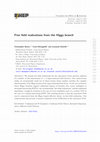
Journal of High Energy Physics
We present free field realizations for the associated vertex operator algebras of a number of fou... more We present free field realizations for the associated vertex operator algebras of a number of four-dimensional $$ \mathcal{N} $$ N = 2 superconformal field theories. Our constructions utilize an exceptionally small set of chiral bosons whose number matches the complex dimensionality of the Higgs branch of the superconformal field theory. In the case of theories whose Higgs branches support additional degrees of freedom (free vector multiplets or decoupled interacting SCFTs), the corresponding “free field realizations” include additional ingredients: symplectic fermions in the case of vector multiplets and a C 2 co-finite VOA in the case of a residual interacting SCFT. The resulting picture is that the associated VOA can be constructed from the Higgs branch effective theory via free field realization. Our constructions also provide a natural realization of the R-filtration of the associated VOA.
Physical Review Letters
In this letter I analyze the constraints imposed by unitarity on the flavor central charges of fo... more In this letter I analyze the constraints imposed by unitarity on the flavor central charges of fourdimensional N = 2 SCFTs with general reductive global symmetry groups. I derive several general and far-reaching consequences of unitarity by computing the norms of flavor singlet Higgs branch operators appearing in the squares of "moment map" operators via the associated vertex operator algebra, and imposing the requirement that they be non-negative.
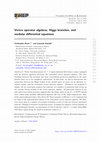
Journal of High Energy Physics
Every four-dimensional $$ \mathcal{N}=2 $$ N = 2 superconformal field theory comes equipped with ... more Every four-dimensional $$ \mathcal{N}=2 $$ N = 2 superconformal field theory comes equipped with an intricate algebraic invariant, the associated vertex operator algebra. The relationships between this invariant and more conventional protected quantities in the same theories have yet to be completely understood. In this work, we aim to characterize the connection between the Higgs branch of the moduli space of vacua (as an algebraic geometric entity) and the associated vertex operator algebra. Ultimately our proposal is simple, but its correctness requires the existence of a number of nontrivial null vectors in the vacuum Verma module of the vertex operator algebra. Of particular interest is one such null vector whose presence suggests that the Schur index of any $$ \mathcal{N}=2 $$ N = 2 SCFT should obey a finite order modular differential equation. By way of the “high temperature” limit of the superconformal index, this allows the Weyl anomaly coefficient a to be reinterpreted in ...
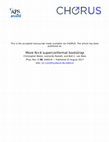
Physical Review D
In this long overdue second installment, we continue to develop the conformal bootstrap program f... more In this long overdue second installment, we continue to develop the conformal bootstrap program for N = 4 superconformal field theories in four dimensions via an analysis of the correlation function of four stress-tensor supermultiplets. We review analytic results for this correlator and make contact with the SCFT/chiral algebra correspondence of [1]. We demonstrate that the constraints of unitarity and crossing symmetry require the central charge c to be greater than or equal to 3/4 in any interacting N = 4 SCFT. We apply numerical bootstrap methods to derive upper bounds on scaling dimensions and OPE coefficients for several low-lying, unprotected operators as a function of the central charge. We interpret our bounds in the context of N = 4 super Yang-Mills (SYM) theories, formulating a series of conjectures regarding the embedding of the conformal manifold-parametrized by the complexified gauge coupling-into the space of scaling dimensions and OPE coefficients. Our conjectures assign a distinguished role to points on the conformal manifold that are self-dual under a subgroup of the S-duality group. This paper contains a more detailed exposition of a number of results previously reported in [2] in addition to new results.
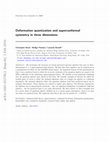
Communications in Mathematical Physics, 2017
We investigate the structure of certain protected operator algebras that arise in threedimensiona... more We investigate the structure of certain protected operator algebras that arise in threedimensional N = 4 superconformal field theories. We find that these algebras can be understood as a quantization of (either of) the half-BPS chiral ring(s). An important feature of this quantization is that it has a preferred basis in which the structure constants of the quantum algebra are equal to the OPE coefficients of the underlying superconformal theory. We identify several nontrivial conditions that the quantum algebra must satisfy in this basis. We consider examples of theories for which the moduli space of vacua is either the minimal nilpotent orbit of a simple Lie algebra or a Kleinian singularity. For minimal nilpotent orbits, the quantum algebras (and their preferred bases) can be uniquely determined. These algebras are related to higher spin algebras. For Kleinian singularities the algebras can be characterized abstractly-they are spherical subalgebras of symplectic reflection algebras-but the preferred basis is not easily determined. We find evidence in these examples that for a given choice of quantum algebra (defined up to a certain gauge equivalence), there is at most one choice of canonical basis. We conjecture that this is the case for general N = 4 SCFTs.
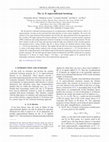
Physical Review D, 2016
We develop the conformal bootstrap program for six-dimensional conformal field theories with (2, ... more We develop the conformal bootstrap program for six-dimensional conformal field theories with (2, 0) supersymmetry, focusing on the universal four-point function of stress tensor multiplets. We review the solution of the superconformal Ward identities and describe the superconformal block decomposition of this correlator. We apply numerical bootstrap techniques to derive bounds on operator product expansion (OPE) coefficients and scaling dimensions from the constraints of crossing symmetry and unitarity. We also derive analytic results for the large spin spectrum using the light cone expansion of the crossing equation. Our principal result is strong evidence that the A 1 theory realizes the minimal allowed central charge (c ¼ 25) for any interacting (2, 0) theory. This implies that the full stress tensor four-point function of the A 1 theory is the unique unitary solution to the crossing symmetry equation at c ¼ 25. For this theory, we estimate the scaling dimensions of the lightest unprotected operators appearing in the stress tensor operator product expansion. We also find rigorous upper bounds for dimensions and OPE coefficients for a general interacting (2, 0) theory of central charge c. For large c, our bounds appear to be saturated by the holographic predictions obtained from eleven-dimensional supergravity.
An A 2 Fibration and the Geometric Engineering of a Metastable Vacuum. 4.2.1. Large N dual geomet... more An A 2 Fibration and the Geometric Engineering of a Metastable Vacuum. 4.2.1. Large N dual geometry .
Journal of High Energy Physics, 2016
In this work we initiate the conformal bootstrap program for N = 2 superconformal field theories ... more In this work we initiate the conformal bootstrap program for N = 2 superconformal field theories in four dimensions. We promote an abstract operator-algebraic viewpoint in order to unify the description of Lagrangian and non-Lagrangian theories, and formulate various conjectures concerning the landscape of theories. We analyze in detail the four-point functions of flavor symmetry current multiplets and of N = 2 chiral operators. For both correlation functions we review the solution of the superconformal Ward identities and describe their superconformal block decompositions. This provides the foundation for an extensive numerical analysis discussed in the second half of the paper. We find a large number of constraints for operator dimensions, OPE coefficients, and central charges that must hold for any N = 2 superconformal field theory.
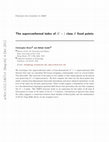
We investigate the superconformal index of four-dimensional N=1 superconformal field theories tha... more We investigate the superconformal index of four-dimensional N=1 superconformal field theories that arise on coincident M5 branes wrapping a holomorphic curve in a local Calabi-Yau three-fold. The structure of the index is very similar to that which appears in the special case preserving N=2 supersymmetry. We first compute the index for the fixed points that admit a known four-dimensional ultraviolet description and prove infrared equivalence at the level of the index for all such constructions. These results suggest a formulation of the index as a two-dimensional topological quantum field theory that generalizes the one that computes the N=2 index. The TQFT structure leads to an expression for the index of all class S fixed points in terms of the index of the N=2 theories. Calculations of spectral data using the index suggests a connection between these families of fixed points and the mathematics of SU(2) Yang-Mills theory on the wrapped curve.
Journal of High Energy Physics, 2015
Four-dimensional N = 2 superconformal field theories have families of protected correlation funct... more Four-dimensional N = 2 superconformal field theories have families of protected correlation functions that possess the structure of two-dimensional chiral algebras. In this paper, we explore the chiral algebras that arise in this manner in the context of theories of class S. The class S duality web implies nontrivial associativity properties for the corresponding chiral algebras, the structure of which is best summarized in the language of generalized topological quantum field theory. We make a number of conjectures regarding the chiral algebras associated to various strongly coupled fixed points.
Journal of High Energy Physics, 2015
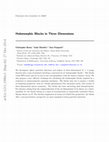
Journal of High Energy Physics, 2014
We decompose sphere partition functions and indices of three-dimensional N = 2 gauge theories int... more We decompose sphere partition functions and indices of three-dimensional N = 2 gauge theories into a sum of products involving a universal set of "holomorphic blocks". The blocks count BPS states and are in one-to-one correspondence with the theory's massive vacua. We also propose a new, effective technique for calculating the holomorphic blocks, inspired by a reduction to supersymmetric quantum mechanics. The blocks turn out to possess a wealth of surprising properties, such as a Stokes phenomenon that integrates nicely with actions of three-dimensional mirror symmetry. The blocks also have interesting dual interpretations. For theories arising from the compactification of the six-dimensional (2, 0) theory on a threemanifold M , the blocks belong to a basis of wavefunctions in analytically continued Chern-Simons theory on M. For theories engineered on branes in Calabi-Yau geometries, the blocks offer a non-perturbative perspective on open topological string partition functions.
Nuclear Physics B, 2008
We use large N duality to study brane/anti-brane configurations on a class of Calabi-Yau manifold... more We use large N duality to study brane/anti-brane configurations on a class of Calabi-Yau manifolds. With only branes present, the Calabi-Yau manifolds in question give rise to N = 2 ADE quiver theories deformed by superpotential terms. We show that the large N duality conjecture of [1] reproduces correctly the known qualitative features of the brane/anti-brane physics. In the supersymmetric case, the gauge theories have Seiberg dualities, which are represented as flops in the geometry. Moreover, the holographic dual geometry encodes the whole RG flow of the gauge theory. In the non-supersymmetric case, the large N duality predicts that the brane/anti-brane theories also enjoy such dualities, and allows one to pick out the good description at a given energy scale.
Nuclear Physics B, 2008
We propose a new way of using geometric transitions to study metastable vacua in string theory an... more We propose a new way of using geometric transitions to study metastable vacua in string theory and certain confining gauge theories. The gauge theories in question are N = 2 supersymmetric theories deformed to N = 1 by superpotential terms. We first geometrically engineer supersymmetry-breaking vacua by wrapping D5 branes on rigid 2-cycles in noncompact Calabi-Yau geometries, such that the central charges of the branes are misaligned. In a limit of slightly misaligned charges, this has a gauge theory description, where supersymmetry is broken by Fayet-Iliopoulos D-terms. Geometric transitions relate these configurations to dual Calabi-Yaus with fluxes, where H RR , H NS and dJ are all nonvanishing. We argue that the dual geometry can be effectively used to study the resulting non-supersymmetric, confining vacua.
Communications in Mathematical Physics, 2015
We describe a new correspondence between four-dimensional conformal field theories with extended ... more We describe a new correspondence between four-dimensional conformal field theories with extended supersymmetry and two-dimensional chiral algebras. The meromorphic correlators of the chiral algebra compute correlators in a protected sector of the four-dimensional theory. Infinite chiral symmetry has far-reaching consequences for the spectral data, correlation functions, and central charges of any four-dimensional theory with N = 2 superconformal symmetry.
Journal of High Energy Physics, 2014
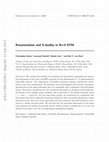
Journal of High Energy Physics, 2014
We consider the problem of resumming the perturbative expansions for anomalous dimensions of low ... more We consider the problem of resumming the perturbative expansions for anomalous dimensions of low twist, non-BPS operators in four dimensional N = 4 supersymmetric Yang-Mills theories. The requirement of S-duality invariance imposes considerable restrictions on any such resummation. We introduce several prescriptions that produce interpolating functions on the upper half plane that are compatible with a subgroup of the full duality group. These lead to predictions for the anomalous dimensions at all points in the fundamental domain of the complex gauge coupling, and in particular at the duality-invariant values τ = i and τ = exp(iπ/3). For low-rank gauge groups, the predictions are compatible with the bounds derived by conformal bootstrap methods for these anomalous dimensions; within numerical errors, they are in good agreement with the conjecture that said bounds are saturated at a duality-invariant point. We also find that the anomalous dimensions of the lowest twist operators lie within an extremely narrow window around a straight line as we vary the moduli of the theory over the two dimensional fundamental domain.

Uploads
Papers by Christopher Beem